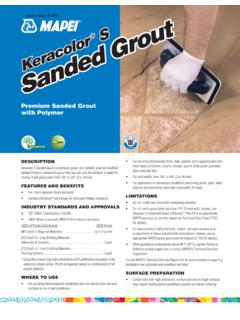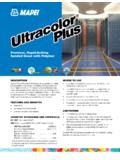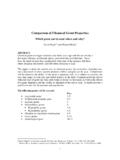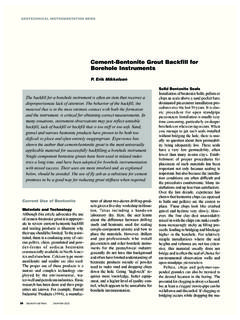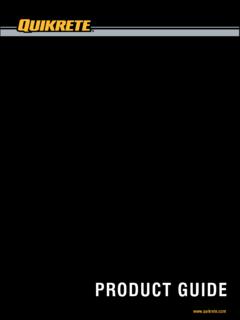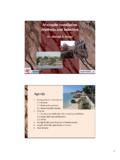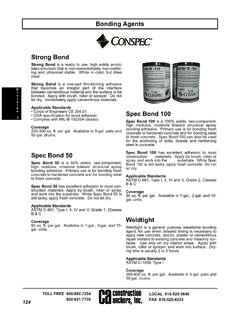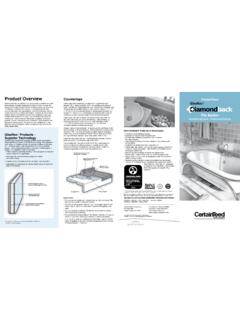Transcription of Specifying Successful Ceramic & Stone Tiles Installations
1 Specifying Successful Ceramic & Stone Tiles Installations Beyond TCA and ANSI Provider: J257 Program: D201 082010 Thank you for joining us! This program is registered with the AIA/CES for continuing professional education. As such, it does not include content that may be deemed or construed to be an approval or endorsement by the AIA of any material of construction or any method or manner of handling, using, distributing, or dealing in any material or product. Questions related to specific materials, methods, and services will be addressed at the conclusion of this presentation. Who Am I? Jim Whitfield FCSI, CCPR, CTC, LEED AP Technical Manager Parex USA (CSI) Construction Specifications Institute President Elect SW Region Education Committee member Fellows Teller Committee Former President Pikes Peak Chapter (2) (MMSA) Materials, Methods, Standards Association President Voting ANSI, ASTM & ISO representative (TCNA) Tile Council of North America Board Member Membrane Committee Mortars and Grouts Committee (NTCA)
2 National Tile Contractors Association Technical Committee Member Standards & Methods Understand Tile Setting Materials & Application Methods Review Industry Standards & Resources TCNA - Tile Council of North America ANSI - American National Standards Institute Understand Specialty Products used for Tile & Stone Installations Course Objectives Substrate: Concrete or Wood Structure Substrate: Mortar Bed, Pre-Slope Substrate: Waterproof Membrane Substrate: Mortar Bed Adhesive: Thin Set Grout: Sanded, Polymer Modified Tile & Stone installation Materials Thin Set (or Thin-Bed) Most popular method, used when Tiles are smaller format tile Thickness is very uniform, floor substrate is relatively flat and level Can be applied 3/32 1/4 (nominal) thick after beat in Tile & Stone installation Materials Tile & Stone installation Materials Medium Bed In process of being recognized by TCNA Medium Bed mortars can be troweled thicker than traditional thin set mortars Allows thick-set attributes to be used for thin set applications Can be applied 1/8 3/4 thick after beat in Used for large format Tiles , inconsistent thickness dimensional Stone .
3 Slight substrate irregularity Setting Methods Industry Standards QUESTION ANSWER Industry Standards Committee meets every 2 years Similar rules as ANSI Published annually for over 45 years Committee adopted 14 new methods in 2002 15 new methods in 2004 7 new methods in 2007 1 new method in 2009 2011 will bring a major renovation to the TCNA Handbook Industry Standards Tile Council of America Handbook 2010 Relationship to ANSI 96 installation methods New methods Changes Industry Standards Both the TCNA handbook & ANSI Standards are voluntary standards There is no compliance requirement, They are heavily followed by the courts! installation Materials Setting materials Grouting materials Backer boards Waterproofing & crack isolation membranes Special installation guidelines installation Guides installation Methods Floors, exterior & interior Walls, exterior & interior Ceilings and soffits Bathtubs & shower walls & receptors Countertops Swimming pools Radiant heated floors Renovations Steam rooms, refrigerated rooms, fountains Movement Joints TCNA: What s Included?
4 TCA Handbook for Ceramic Tile installation Method F113-07 Dry-Set Mortar or Latex-Portland cement Mortar Recommended Uses: on plane, clean concrete. on slab-on-grade construction where no bending stresses occur. see page 17 NOTE for exterior uses. see CAUTION at bottom of page Limitations: method F111 is the preferred method over precast concrete floor systems, post-tensioned concrete floor systems, and other floors subject to movement or deflection Preparation by Other Trades: slab steel trowel and fine broom finish free of curing compounds. (When used, mechanical scarifying is necessary.) slope, when required, to be in sub-floor max. variation in the slab 1/4" in 10'-0" from the required plane Movement Joint (Architect must specify type of joint and show location and details on drawings) follow EJ171, page 68, for slab-on-grade Installations above-grade structural slabs require: exterior joint spacing; perimeter joints are mandatory installation Specifications: tile ANSI grout ANSI method F113 may be suitable for above-grade structural slab Installations when specific mortar and grout products recommended by the manufacturer are specified.
5 Not all modified mortar and grout products are suitable for this application. deflection not to exceed 1/360 of span for above-grade structural slabs. slab to be well cured, dimensionally stable, and free of cracks, waxy or oily films, and curing compounds. bond coat 3/32" min. Materials: mortar use ANSI or for slab-on-grade Installations ; use only a manufacturer's designated mortar for above-grade structural slabs grout use ANSI , , , or for slab-on-grade Installations ; use only a manufacturer's designated grout for above-grade structural slabs TCNA Method: EXAMPLE QUESTION EXPANSION JOINTS Interior Joints changed from 24 ft 36 ft to 20 ft 25 ft Exterior joints changes from 12 ft 16 ft to 8 ft 12 ft TCNA: Recent Changes IMPORTANT EDITORIAL CHANGES TCNA: Recent Changes New definition for maximum allowable deflection for substrates installed by other trades NEW DEFLECTION LANGUAGE Floor systems, including the framing system and sub-floor panels, over which the tile will be installed using the appropriate TCA method shall be in conformance with the IRC for residential applications, the IBC for commercial applications, or applicable building codes.
6 TCNA: Recent Changes OLD DEFLECTION LANGUAGE Ceramic tile Installations require the floor areas over which tile is to be applied to have a deflection not greater than L/360 of the span when measured under a 300 lb. concentrated load (see ASTM C627). TCNA: Recent Changes NEW DEFLECTION LANGUAGE Continued Note: The owner should communicate in writing to the project design professional and general contractor the intended use of the tile installation , in order to enable the project design professional and general contractor to make necessary allowances for the expected live load, concentrated loads, impact loads, and dead loads including weight of the tile and setting bed. The tile installer shall not be responsible for problems resulting from any floor framing or sub-floor installation not compliant with applicable building codes, unless the tile installer or tile contractor designs and installs the floor framing or sub-floor.
7 Major Changes in 2011 TCNA Handbook The addition of ISO designations to ANSI & Material Standards New Environmental Conditions (Wet Areas) Revisions to TCNA Steam Room details New, separate TCNA installation Handbook for Dimensional Stone Tile Weighted Assemblies TCNA 2011: Major Changes Major Changes in 2011 TCNA Handbook The addition of ISO designations to ANSI & Material Standards New Environmental Conditions (Wet Areas) Revisions to TCNA Steam Room details New, separate TCNA installation Handbook for Dimensional Stone Tile Weighted Assemblies TCNA 2011: Major Changes Major Changes in 2011 TCNA Handbook Tiles with all edges shorter than 15. Maximum allowable variation is in 10 from the required plane and no more than 1/16 variation in 12 from any high points in the surface.
8 Tiles with at least one edge 15 or longer in length maximum allowable variation is 1/8 in 10 with no more than 1/16 in 24 from the high points. TCNA 2011: Major Changes TCNA 2011: Major Changes ISO Classifications Adhesives Only Types Classes Special Characteristics C - Cementitious 1 - Normal F - Fast Setting (thin set mortars) 2 - Improved T - Slip Resistance E - -Extended Open Time S1 - Deformability S2 - Highly Deformable P1 - Plywood adhesion P2 - Improved Plywood Adhesion D - Dispersion 1 - Normal F - Fast Drying (mastic) 2 - Improved T - Slip Resistance E - -Extended Open Time R - Reaction resin 1 - Normal T - Slip Resistance (Epoxies) 2 - Improved TCNA 2011: Major Changes Number Class Description Cementitous Thinsets C 1 Normal cementitious adhesive C 1 F Fast setting cementitious adhesive C 1 T Normal cementitious adhesive with slip resistance C 1 FT Fast setting cementitous adhesive with slip resistance C 2 Cementitious adhesive with improved characteristics C 2 E Cementitous adhesive with improved characteristics and extended open time C 2 F Fast setting cementitous adhesive with improved characteristics C 2 T Cementitous adhesive with improved characteristics and slip resistance C 2 TE Cementitious adhesive with improved characteristics.
9 Slip resistance and extended open time C 2 FT Fast setting cementitious adhesive with improved characteristics and slip resistance Dispersion Mastics D 1 Normal dispersion adhesive D 1 T Normal dispersion adhesive with slip resistance D 2 T Dispersion adhesive with improved characteristics with slip resistance D 2 TE Dispersion adhesive with improved characteristics, slip resistance and extended open time Reaction Resin Epoxies R 1 Normal reaction resin adhesive R 1 T Normal reaction resin adhesive with slip resistance R 2 Reaction resin adhesive with improved characteristics R 2 T Reaction resin adhesive with improved characteristics and slip resistance TCNA 2011: Major Changes MERKRETE and ISO ISO example for internal use only, not for external use. ISO testing in process -(C1) (TE) 700 PremiumSet (R2) Chemical Resistant, Water ProEpoxy Mortar and Grout Cleanable Tile Setting and Grouting Epoxy and Water Cleanable Tile-Setting Epoxy Adhesive - (C2)(P1) Latex-Portland cement Mortar 705 ProSet Plus - (C2)TE 7d10 Dustless (C2)(P1)(S1) 720 MarblePro (C2)(P2)(S2) 735 Premiumflex (C2)(P2)(S2) 740 Fracture Guard Thinset (C2)(P2)(S2) F 750 RS Thin-Set (C2) (S2) 801 SelfCure Thinset (C2) (S2) 200 Krete liquid & 211 Krete powder (C2) (S2) 820 Merlite When combined with 150 Acrylic admixture: (C1) 700 PremiumSet (D1)T Organic Adhesives for installation of 136 Surestik (D2)T Ceramic Tile TCNA 2011: Major Changes TCNA 2011: Major Changes TCNA 2011: Major Changes TCNA 2011.
10 Major Changes Com1 Commercial Dry Examples: Commercial interior wall, floor and ceiling/soffit applications, and decorative areas Com2 Commercial Limited Water Exposure Examples: Dairies, breweries, kitchen walls, locker rooms Com3 Commercial Wet Examples: Commercial gang showers, tub enclosures, laundries, showers Com4 Commercial High Humidity, Heavy Moisture Exposure Examples: Steam showers, steam rooms, enclosed pool areas, natatoriums Com5 Commercial High Temperature ( 125 F) Examples: Commercial saunas, furnace or boiler areas Com6 Commercial Exterior Examples: Exterior walls Industry Standards ANSI Handbook Specifications for the installation of Ceramic Tile Revised every five years? Referred to in TCNA Handbook Methods Important Specifications Environmental Conditions Coverage Types of ANSI Standards A108: installation Standards A118 & A136: Material Specifications A137: Specifications for Ceramic Tile Revisions 2007 7 new methods & change in deflection criteria Industry Standards What is ANSI?

